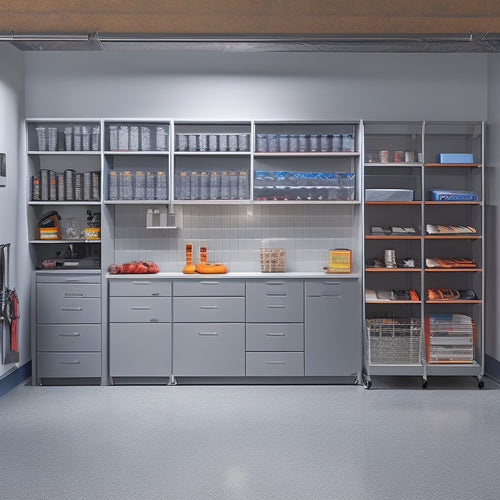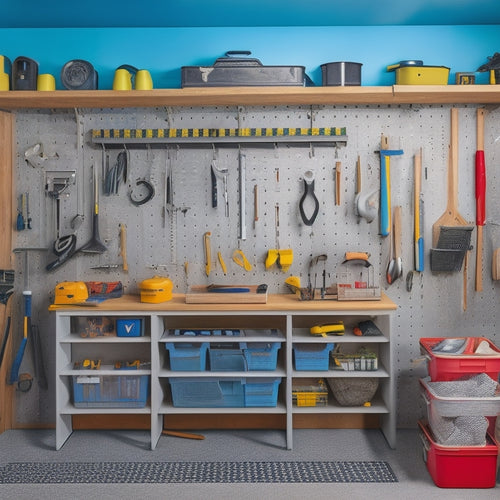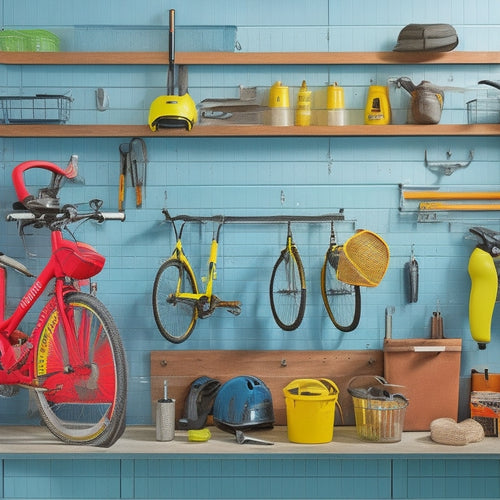
Laundry Room Pegboard Installation: A Step-by-Step Guide
Share
You're about to transform your laundry room into a clutter-free haven by installing a pegboard. Start by measuring your available wall space and considering the size and shape of your pegboard. Think about the items you want to hang and the aesthetics you're aiming for. Sketch out a rough layout, evaluating any obstacles or limitations. Clear clutter, evaluate your laundry room dimensions, and identify space constraints. Next, assemble your pegboard frame, ensuring it's level and securely anchored to wall studs. You're now ready to add hooks and accessories, but that's just the beginning – you'll want to fine-tune your installation for the best positioning and workflow.
Key Takeaways
• Assess the laundry room's dimensions and identify space constraints to determine the ideal pegboard size and layout.
• Assemble the pegboard frame following the manufacturer's instructions, ensuring square and level corners for secure mounting.
• Measure the wall space accurately to anchor the frame to wall studs, providing stability and preventing damage.
• Select hooks and accessories based on the items to be hung, considering weight capacity and aesthetics for a visually appealing arrangement.
• Maintain a clutter-free environment by designating areas for dirty laundry, folding, and ironing, and optimizing storage solutions for a seamless workflow.
Planning Your Pegboard Layout
Determine the available space on your laundry room wall by measuring the width and height of the area where you plan to install the pegboard, then consider the size and shape of the pegboard you want to use. This will help you decide on the best layout for your pegboard.
Think about the Pegboard Aesthetics you want to achieve - do you prefer a sleek and modern design or a more rustic, country-inspired look? Consider your Laundry Themes, too - will it be bright and cheerful or soft and calming?
Next, make a list of the items you want to hang on your pegboard, such as baskets, hooks, and bins. This will give you an idea of the type and number of pegs you'll need. You can also think about any power outlets or shelves you might want to incorporate into your design.
With these details in mind, you can start sketching out a rough layout of your pegboard. Don't worry too much about perfection at this stage - just focus on getting your ideas down on paper.
Preparing the Laundry Room
Now that you've planned your pegboard layout, it's time to prepare your laundry room for installation.
Before you start, you'll need to assess the space to identify any obstacles or limitations that might impact your design.
You'll also need to clear the clutter and remove any items that could get in the way of your installation.
Laundry Space Assessment
Evaluating your laundry room's dimensions, layout, and existing storage solutions is essential to determining the best placement and design of your pegboard. Take a closer look at your space and consider your laundry goals. What do you want to achieve with your pegboard installation? Do you want to increase storage, improve organization, or enhance the overall aesthetic of your laundry room?
| Space Constraints | Laundry Goals |
|---|---|
| Limited wall space | Maximize vertical storage |
| Narrow room width | Opt for a compact pegboard design |
| Existing shelves or cabinets | Integrate pegboard with existing storage |
| High ceiling | Take advantage of overhead storage |
| Corner space | Utilize a corner-mounted pegboard |
As you assess your space, identify any constraints that might impact your pegboard design. Consider the dimensions of your walls, the location of any windows or doors, and the existing storage solutions. By understanding your space and laundry goals, you can create a pegboard design that meets your specific needs and enhances your laundry room's functionality.
Clear the Clutter
Before installing your pegboard, remove any items from the walls and floor to create a blank canvas, allowing you to visualize the space and identify any potential obstacles. This step is vital in adopting an organizing mindset, where you'll assess what you need to keep, donate, or discard. Decluttering strategies come into play here, so take your time to sort items into categories. Be ruthless – if you haven't used something in the past year, it's likely you won't miss it.
Next, sort items into categories like 'keep,' 'donate,' and 'recycle.' This will help you see what you can purge and what you can repurpose. Take everything off the shelves and dust those surfaces to create a clean slate. Consider the items you're keeping and how you can optimize their storage. You might need to invest in bins or baskets to keep items hidden from view.
Installing the Pegboard Frame
You'll start by assembling the pegboard frame according to the manufacturer's instructions, ensuring all corners are securely attached and the frame is square.
Next, you'll measure the wall space where the pegboard will be mounted, taking note of any obstacles, such as outlets or switches.
With these critical measurements in hand, you'll be ready to proceed with installing the frame.
Pegboard Frame Assembly
Assemble the pegboard frame by attaching the horizontal rails to the vertical stiles using the provided screws, making sure the corners are square and the frame is level. Be sure to follow the manufacturer's instructions for specific assembly requirements, as different pegboard materials may have unique assembly processes. For instance, if you're working with a metal frame style, you may need to use additional hardware or specialized tools.
Once the frame is assembled, double-check that it's level and plumb. You can use a spirit level or a laser level to guarantee accuracy. If you notice any deviations, adjust the frame accordingly to prevent future installation issues.
With the frame assembled and leveled, you're ready to move on to the next step.
Take a moment to admire your handiwork – you've successfully built the foundation of your pegboard installation. Now, you're one step closer to creating a functional and organized laundry room space that suits your needs.
Measuring the Wall Space
What's the ideal location for your pegboard frame on the laundry room wall, taking into account the surrounding fixtures, outlets, and any other obstructions that might impact its placement? You'll want to identify a spot that's easily accessible, yet out of the way of high-traffic areas.
Take a moment to examine the wall's layout, noting the location of wall studs, outlets, and any other features that might affect your installation.
Using a level and a tape measure, determine the width and height of the area where you plan to install the pegboard frame. Make sure to account for any corner angles or obstructions that might impact the frame's fit.
You'll also want to identify the wall studs, as you'll need to anchor the frame to them for maximum stability. Mark the wall with a pencil, indicating the spot where you'll place the frame's screws.
Double-check your measurements to confirm accuracy, and make any necessary adjustments before moving on to the next step.
With your wall space measured and marked, you're ready to begin installing your pegboard frame.
Adding Hooks and Accessories
Now that your pegboard is securely mounted, add hooks and accessories to create a customized storage system that suits your laundry room's specific needs.
When selecting hooks, consider the types of items you'll be hanging. For instance, if you have a lot of heavy items like ironing boards or laundry bags, opt for sturdy hooks with a high weight capacity. On the other hand, if you're looking to store lighter items like cleaning supplies or accessories, smaller hooks will suffice. Hook styles range from simple L-hooks to more decorative options with a finish that matches your laundry room's aesthetic.
Accessory trends include adding bins, baskets, or shelves to store items like detergent, fabric softener, or stain removers. You can also incorporate a utility holder for scissors, a tape dispenser, or a paper towel roll. Consider your personal needs and the space available on your pegboard when choosing accessories.
Don't overcrowd the board, leaving enough space between hooks and accessories for easy access and a visually appealing arrangement.
Organizing Your Laundry Space
With your pegboard fully loaded, turn your attention to optimizing the surrounding laundry space to create a seamless workflow. Now it's time to put your laundry hacks to the test!
Consider the 'landing strip' concept, where you designate a specific area for dirty laundry, making it easy to sort and prioritize. Utilize storage solutions like baskets, bins, or shelves to keep detergent, fabric softener, and other essentials within arm's reach.
Think vertically by installing shelves or a storage unit above your washer and dryer. This will keep your floor clear and prevent clutter from building up.
Make the most of your laundry room's corners by using carousels or lazy susans to store items like stain removers, bleach, or laundry bags.
Don't forget to leave some space for a folding station or ironing board, ensuring a smooth progression from washing to folding.
Final Touches and Adjustments
As you step back to admire your newly organized laundry room, take a moment to assess the functionality and flow of the space, making any necessary adjustments to guarantee a seamless laundry experience. Now's the time to fine-tune your pegboard installation, ensuring every hook, bin, and accessory is precisely where you need it.
Double-check that frequently used items are easily accessible, and less-used items are stored out of the way. Make any design tweaks to optimize your workflow. Consider adding labels or signs to identify storage bins and hooks, keeping your laundry space organized and clutter-free.
For long-term Pegboard Maintenance, establish a regular cleaning routine to prevent dust and dirt buildup. Gently wipe down the pegboard with a damp cloth, and inspect hooks and accessories for signs of wear. Replace any worn-out components to maintain your pegboard's functionality.
With these final touches, you'll be enjoying a stress-free laundry experience in no time.
Frequently Asked Questions
Can I Install a Pegboard in a Laundry Room With Slanted Ceilings?
You can install a pegboard in a laundry room with slanted ceilings by adapting to the unique ceiling angle, making adjustments to the pegboard's mounting system, and ensuring a secure fit with angle-adjusted brackets and screws.
Are Pegboards Suitable for High-Moisture Laundry Room Environments?
It's important to make sure your pegboard is suitable for high-moisture laundry rooms by selecting materials with moisture resistance and rust protection, such as stainless steel or PVC-coated pegboards, to withstand humidity and water exposure.
Can I Use a Pegboard for Hanging Heavy Laundry Items Like Irons?
You're wondering if a pegboard can handle heavy laundry items like irons? Absolutely! Choose a sturdy pegboard and robust hooks to guarantee iron storage and other laundry accessories stay securely in place.
How Do I Clean and Maintain My Pegboard Over Time?
Did you know 80% of pegboard damage occurs due to neglect? You'll prevent this by performing a daily inspection for dust and debris, and regular sanitizing with a gentle cleaner to keep your pegboard in top shape.
Are There Any Specific Pegboard Materials Recommended for Laundry Rooms?
When selecting a pegboard for your laundry room, you'll want to explore eco-friendly material options like bamboo, recycled plastic, or sustainably sourced wood, which offer durability and a clear conscience.
Related Posts
-

Building a Garage Storage System With Built-Ins
You're about to build a garage storage system with built-ins that fits your unique needs, starting by evaluating your...
-

Advantages of a Pegboard System in Your Garage
You can instantly alter your garage into a more organized, efficient, and productive space by installing a pegboard s...
-

Benefits of Pegboard Racks in Your Garage
By installing a pegboard rack in your garage, you'll reveal a wealth of benefits that change your workspace into a hi...


